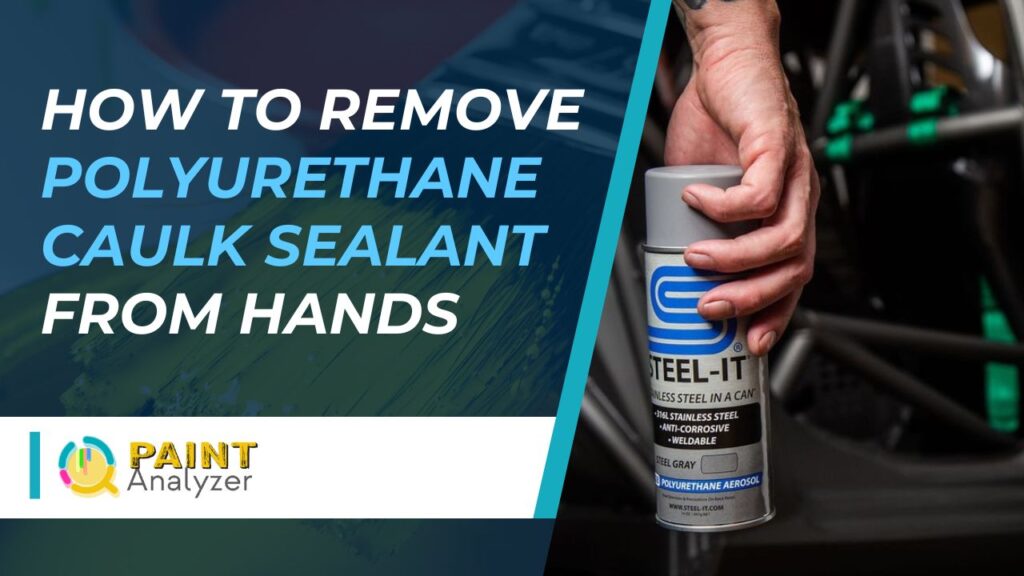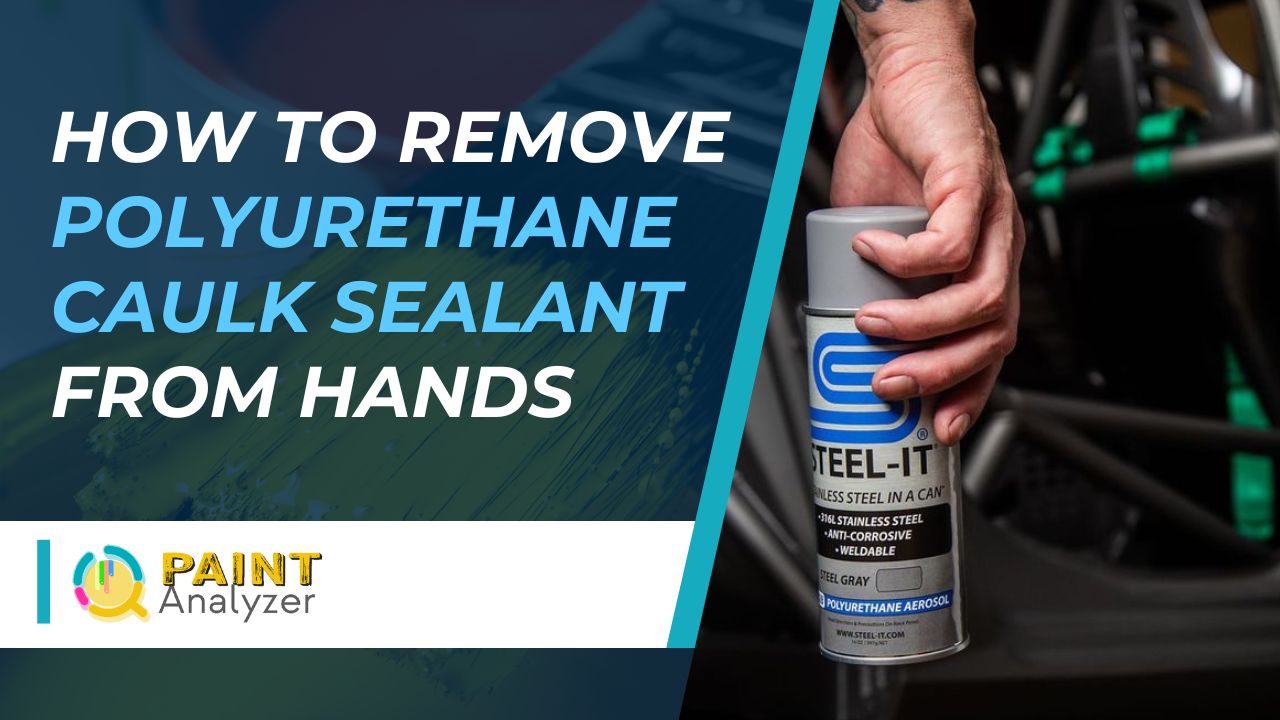Removing polyurethane caulk sealant from hands can be a frustrating and time-consuming task. If you’re a professional contractor or a DIY enthusiast, getting sealant on your skin during a project is easy. The good news is there are effective methods for removing polyurethane caulk sealant from hands without causing damage to the skin.
Begin by acquiring the necessary materials, including mineral spirits, a mild soap, and a Scraper. Utilize the mineral spirits to apply to the sealant, then gently remove with the Scraper. Finally, ensure to wash your hands with soap and water to eliminate any remains of the sealant.
In this article, I’ll walk you through a step-by-step guide on removing polyurethane caulk sealant from your hands using everyday household items and tools. So keep reading!

How to Use Mineral Spirits to Remove Polyurethane Caulk Sealant from Hands?
Removing polyurethane caulk sealant from your hands can be tricky and frustrating. Luckily, if you have mineral spirits on hand, it can be a much easier and quicker process. Here are a few simple steps to help you remove the caulk sealant from your hands using it.
Step 1: Gather the Materials
Alright, let’s get started. The first step in removing polyurethane caulk sealant from your hands is to gather all the necessary materials. You’ll need a few things to make this process go as smoothly as possible. Here’s a list of what you’ll need:
- Solvent: Mineral spirits or a similar product will work great for this. You’ll use this to soften the sealant on your hands so it’s easier to remove.
- Scraper: A plastic scraper or similar tool is perfect for this. You’ll use this to scrape off the softened sealant from your hands gently.
- Hand soap: You’ll need this to wash your hands after the sealant is removed.
- Rubber gloves: These will help protect your hands from getting dirty in the first place.
Step 2: Soften the Sealant
- Start by applying a small amount of solvent to a clean rag or cotton ball.
- Rub the rag or cotton ball onto the sealant on your hands, covering the entire affected area.
- Let the solvent sit on your hands for a few minutes. The exact amount of time will depend on the solvent you’re using and the thickness of the sealant.
- Use the Scraper to scrape off the softened sealant gently.
Remember that you should not use your bare hands to apply the solvent, which can be harsh on the skin. Instead, use a rag or cotton ball. And always make sure to read and follow the manufacturer’s instructions when using a solvent.
Step 3: Testing the Softness
Now, when it comes to testing the sealant’s softness, you can use a simple trick. Gently press the Scraper against the sealant. If the sealant is soft, it should come off easily. But if it’s still hard and difficult to remove, you may need to let the solvent sit on your hands for a little longer.
Step 4: Removing the Sealant
When removing the sealant, be gentle. Scrap it off in a downward motion and avoid using too much pressure. You don’t want to damage your skin in the process. And if you find that the sealant is still stubborn and won’t come off easily, you can always apply more solvent and let it sit for a little longer.
Step 5: Wash the Hands
This step is essential because it will help to remove any remaining residue and restore the skin’s natural pH balance.
- Start by rinsing your hands under warm water to remove any remaining solvent or sealant.
- Next, apply a small amount of hand soap to your hands and lather well.
- Rub your hands together for at least 20 seconds, and cover all surfaces.
- Rinse your hands well under warm water, and dry them with a clean towel.
It’s essential to use mild hand soap, as harsh soaps can dry out your skin. And don’t forget to lather up for at least 20 seconds to ensure all surfaces are clean.
Step 6: Avoiding Dry Skin
After washing your hands, you might notice your skin feeling dry and tight. To avoid this, apply a small amount of moisturizer to your hands. Look for a moisturizer formulated for sensitive skin, as this will be less likely to irritate. You can also use coconut oil or olive oil as an alternative.
Step 7: Final Checks
Once you’ve washed and dried your hands, take a final look to ensure no remaining sealant. If you see any, repeat the process of using solvent and Scraper.
How to Remove Polyurethane Caulk Sealant from Hands without mineral spirits?
Removing polyurethane caulk sealant from hands without using mineral spirits can be done using alternative solvents or mechanical methods. Here are a few options to consider:
Method 1: Rubbing alcohol
Rubbing alcohol can be used as a substitute for mineral spirits to soften the sealant on your hands. Simply apply a small amount of rubbing alcohol to a rag or cotton ball and rub it onto the sealant. Allow it to sit for a few minutes before using a scraper to remove the softened sealant.
Method 2: White vinegar
The sealant can also be softened using white vinegar as a solvent. Dab a cotton ball or rag with a little vinegar and rub the sealant with it. Allow it to sit for a while before using a scraper to remove the softened sealant.
Method 3: Heat gun
You can soften the sealant on your hands by using a heat gun. Keep the heat gun a few inches away from the sealant and aim it at it. Take care not to burn yourself or the area around you. Scrape the sealant off with a scraper once it has softened.
Method 4: Scraper
If the sealant is not too thick and old, you can try scraping it off with a scraper without using any solvent. This can be done by using a plastic scraper or a putty knife. Be sure to use a dull edge, as a sharp edge can cause injury, and avoid using too much pressure.
Method 5: Soap and water
In some cases, if the sealant is not too old or thick, you can try removing it with soap and water. Start by washing your hands with warm water and soap, then gently rub the sealant with your fingers. Be gentle to avoid damaging your skin, and repeat the process if necessary.
Method 6: Peanut butter
Use peanut butter as a natural solvent to remove the sealant from your hands. Allow a small amount of peanut butter to sit on the sealant for a few minutes. Then, using a scraper, carefully remove the sealant.
Method 7: Lemon juice
Natural degreaser lemon juice can soften and remove sealant from your hands. Rub the sealant with a little lemon juice applied to a rag or cotton ball. Allow it to sit for a few minutes before removing the softened sealant with a scraper.
Method 8: Baking soda
Baking soda can be mixed with water to create a paste that can be applied to the sealant on your hands. Let it sit for a few minutes before gently scrubbing the sealant off with a brush or sponge. Rinse your hands with water and dry them.
Can Polyurethane Caulk Sealant be Used to Seal Outdoor Concrete Statues?
Polyurethane caulk sealant is a versatile option for sealing outdoor concrete statues. Not only does it prevent moisture penetration, but it also withstands elements like rain and sunlight. Cleaning and painting outdoor statues before applying the sealant ensures a smooth and durable finish, enhancing their longevity. Remember to choose a polyurethane caulk specifically designed for outdoor use to achieve optimal results.
Can the Method for Removing Resin from Hands Also Work for Polyurethane Caulk Sealant?
Yes, the method for getting resin off hands can also work for polyurethane caulk sealant. Simply apply a generous amount of olive oil or vinegar to the affected area and gently rub. The caulk should start to break down and can be easily removed.
How to prevent it from happening?
If you’re a DIYer, you know that one of the best ways to protect your home from weather-related damage is to use a polyurethane caulk sealant. But if you’re not careful, you can end up with a mess on your hands. Here, I’ll show you how to prevent polyurethane caulk sealant from getting on your hands.
- Always wear rubber gloves when working with sealant. This will protect your hands from getting dirty in the first place.
- Be more careful when applying the sealant. Only apply it to the intended surface and avoid getting it on your hands.
- Clean up any excess sealant immediately. The longer the sealant sits on your hands, the harder it will be to remove.
Using a Caulk Removal Tool
Another thing you can do is use a caulk removal tool. These tools are specifically designed to remove sealant and can make the process much easier. You can find them at most hardware stores or online. They’re not expensive and worth having in your toolbox.
Safety First
It’s also important to remember that sealants and solvents can be hazardous to your health. Always read and follow the manufacturer’s instructions and take all necessary safety precautions.
Silicone Remover versus Wd-40
Conclusion
Here, I’ve provided a step-by-step guide on how to remove polyurethane caulk sealant from hands. You can remove the sealant from your hands without harming your skin if you follow the steps outlined in this guide.
I’ve also talked about how to avoid getting sealant on your hands in the first place, such as using rubber gloves and being more careful when applying the sealant.
I hope you found this helpful guide and that it helps your next project go more smoothly. Always use caution and safety precautions when working with solvents and sealants, and don’t hesitate to contact us if you have any further questions. Thank you for reading!

